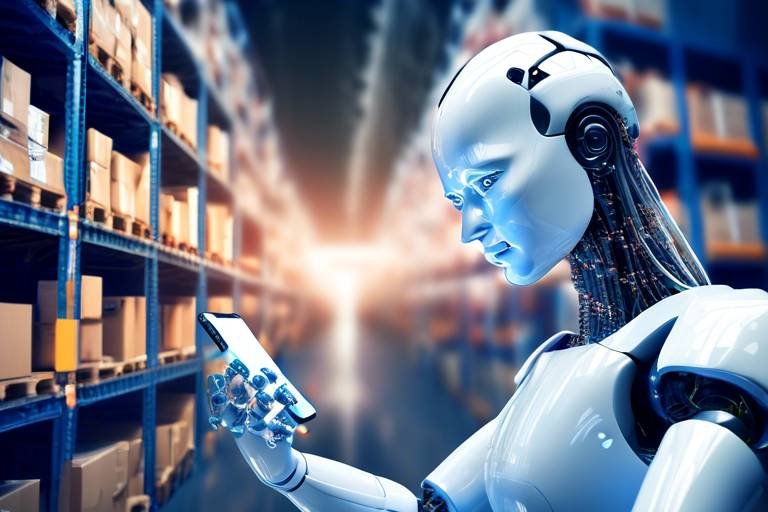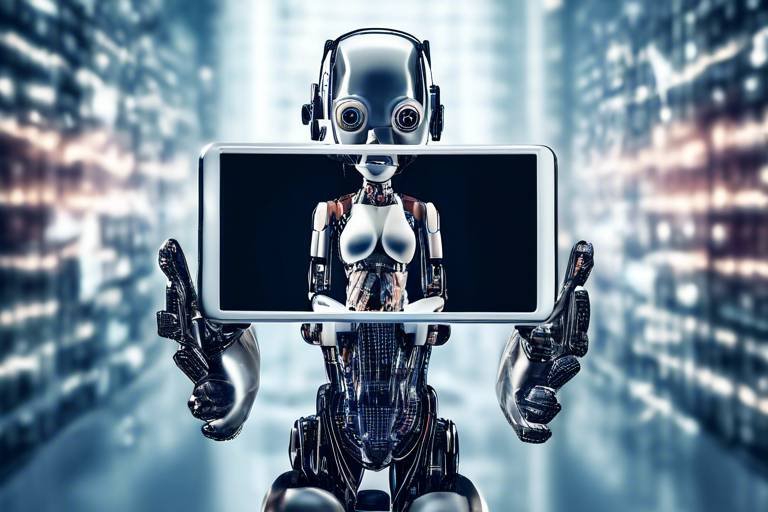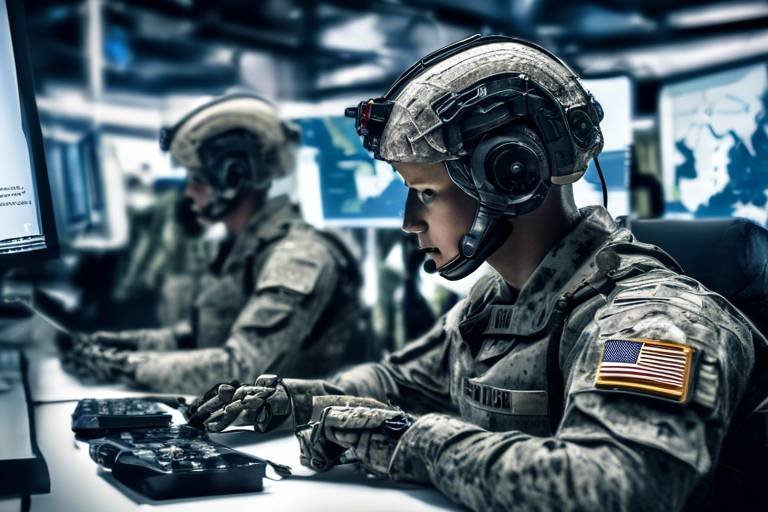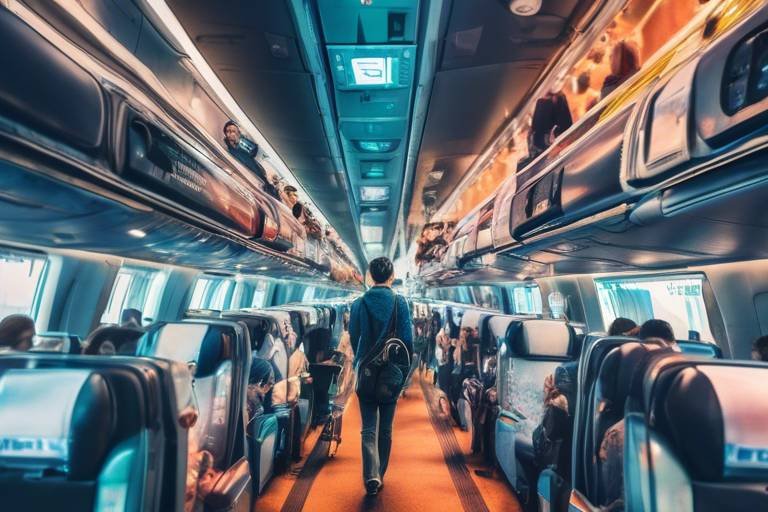AI in the Fashion Industry: How Technology is Driving Trends
The world of fashion is undergoing a seismic shift, and at the heart of this transformation is artificial intelligence (AI). Imagine a world where designers can create stunning collections by merely inputting a few ideas into a computer, which then generates unique patterns and styles. Sounds like something out of a sci-fi movie, right? But this is the reality we are stepping into. AI is not just a buzzword; it’s a powerful tool that is reshaping how fashion is conceived, produced, and marketed.
From the moment a designer dreams up a new collection to the instant a customer clicks 'buy', AI is influencing every step of the fashion journey. This technology is enabling brands to analyze consumer preferences and predict trends with astonishing accuracy. It's like having a crystal ball that reveals what styles will be hot next season, allowing brands to stay ahead of the curve. In an industry where timing is everything, AI is proving to be the ultimate game-changer.
Moreover, the integration of AI in fashion is fostering a more personalized shopping experience. Picture this: you walk into a store or browse online, and the recommendations you receive are tailored specifically to your tastes. AI algorithms analyze your past purchases, browsing habits, and even social media interactions to suggest items you’re likely to love. It’s all about creating a unique customer journey that feels personal and engaging. This level of personalization not only enhances customer satisfaction but also boosts brand loyalty.
As we delve deeper into the transformative impact of AI in the fashion sector, we’ll explore how it drives design innovations, enhances customer experiences, and contributes to sustainable practices. The future of fashion is not just about looking good; it's about making informed choices that benefit both consumers and the planet. So, buckle up as we embark on this exciting journey through the intersection of fashion and technology!
- How is AI changing fashion design? AI allows designers to experiment with new styles and patterns quickly, enabling them to innovate while minimizing time and resource investment.
- Can AI predict fashion trends? Yes, AI analyzes vast amounts of data from social media, sales, and consumer behavior to forecast trends accurately.
- What role does AI play in customer experience? AI personalizes shopping experiences by providing tailored recommendations based on individual preferences and behaviors.
- Is AI beneficial for sustainable fashion? Absolutely! AI helps brands optimize resources, reduce waste, and develop eco-friendly materials, promoting sustainability in the industry.

AI-Driven Design Innovations
Artificial intelligence is not just a buzzword; it’s a game-changer in the world of fashion design. Imagine a world where designers can create unique patterns and styles at the click of a button. Sounds futuristic, right? Well, that future is here! AI is revolutionizing the creative process, allowing designers to explore endless possibilities without being bogged down by traditional constraints. With AI algorithms analyzing vast amounts of data, designers can now predict emerging trends based on consumer preferences, ensuring that their creations resonate with the market.
One of the most exciting aspects of AI-driven design is its ability to streamline the creative process. Designers can use AI tools to generate new ideas, refine existing concepts, and even visualize their designs in 3D before they hit the production floor. This not only saves time but also enhances creativity. Think of it as having a brainstorming partner that never runs out of ideas!
Moreover, AI can analyze current fashion trends by scanning social media platforms, fashion blogs, and e-commerce sites, providing designers with real-time insights. This means that a designer can create a collection that’s not only innovative but also aligned with what consumers are currently interested in. Imagine the thrill of being able to design a dress that perfectly matches the colors and styles trending on Instagram right now!
To illustrate how AI is shaping design innovations, let’s take a look at some key areas where technology is making a significant impact:
| Innovation | Description |
|---|---|
| Pattern Generation | AI algorithms can create unique fabric patterns based on consumer preferences and historical sales data. |
| Virtual Prototyping | Designers can visualize garments in a virtual space, allowing for adjustments before physical samples are made. |
| Trend Forecasting | AI analyzes data from various sources to predict future fashion trends, helping brands stay ahead of the curve. |
Additionally, AI can assist in personalizing designs based on individual consumer tastes. Imagine a scenario where a customer can input their style preferences, and AI generates a personalized collection just for them! This level of customization not only enhances the shopping experience but also fosters a deeper connection between consumers and brands.
In conclusion, AI-driven design innovations are transforming the fashion industry in ways we never thought possible. From enhancing creativity to predicting trends and personalizing experiences, the integration of technology is paving the way for a more dynamic and responsive fashion landscape. So, the next time you admire a stunning outfit, remember that behind the scenes, AI might have played a crucial role in bringing that vision to life!

Personalization and Customer Experience
In today's fast-paced digital world, personalization has become the cornerstone of an exceptional customer experience, especially in the fashion industry. With the advent of artificial intelligence, brands are now able to tailor their offerings to meet the unique preferences of each consumer. Imagine walking into a store where every item feels like it was made just for you—this is the magic that AI brings to the table. By analyzing vast amounts of data, AI can identify individual tastes, preferences, and shopping behaviors, creating a shopping experience that feels personal and engaging.
One of the most exciting aspects of AI in fashion is its ability to deliver personalized recommendations. When you browse an online store, you might notice suggestions based on your previous purchases or items you've viewed. This isn't just coincidence; it's AI at work, learning from your interactions and offering choices that align with your style. For instance, if you frequently shop for casual wear, the algorithm will highlight similar styles, ensuring that you don’t miss out on the latest trends that fit your vibe.
Moreover, AI enhances the shopping experience by enabling tailored shopping journeys. Brands can create customized landing pages that reflect the interests of different customer segments. For example, a user interested in sustainable fashion might see a completely different homepage than someone looking for luxury items. This level of customization not only improves user satisfaction but also boosts conversion rates, as customers are more likely to purchase when they see products that resonate with them.
Additionally, AI-driven chatbots and virtual assistants have transformed customer service. These tools provide instant support, answering queries and guiding customers through their shopping journey. Imagine having a virtual stylist available 24/7, ready to help you find the perfect outfit for any occasion! This not only enhances the customer experience but also builds brand loyalty, as consumers appreciate the convenience and personalization.
To further illustrate the impact of AI on personalization, consider the following table that highlights key benefits:
| Benefit | Description |
|---|---|
| Enhanced Recommendations | AI analyzes customer behavior to suggest products that align with individual preferences. |
| Customized Shopping Experience | Brands can create unique landing pages based on customer interests, improving engagement. |
| Instant Customer Support | Chatbots provide real-time assistance, enhancing customer satisfaction and loyalty. |
As we move forward, it's clear that AI is not just a trend; it's a fundamental shift in how the fashion industry approaches customer engagement. By leveraging the power of AI, brands can create experiences that are not only personalized but also deeply connected to consumer needs. This evolution in customer experience is vital for brands aiming to stay competitive in a rapidly changing market.
Q1: How does AI personalize my shopping experience?
A1: AI analyzes your browsing and purchasing history to recommend products that match your style and preferences.
Q2: Can AI improve customer service?
A2: Absolutely! AI-powered chatbots can provide instant support, answering questions and assisting customers anytime.
Q3: Will I see the same recommendations as other customers?
A3: No, recommendations are tailored specifically to your individual preferences, ensuring a unique shopping experience.

Data-Driven Insights
In the fast-paced world of fashion, understanding consumer behavior is akin to having a compass in a dense forest. With the advent of artificial intelligence, brands are no longer navigating blindly; they are equipped with robust data-driven insights that illuminate the path ahead. AI technologies, particularly those leveraging big data, allow fashion companies to delve deep into the psyche of their customers. This means analyzing not just what consumers buy, but also how they interact with brands across various platforms.
Imagine being able to predict a customer's next purchase before they even realize they want it! AI algorithms analyze vast amounts of data—from purchase history and browsing patterns to social media interactions—to identify trends and preferences. For instance, if a brand notices a spike in searches for sustainable materials, they can pivot their marketing strategy to highlight eco-friendly products. This kind of agility is crucial in an industry where trends can change overnight.
Moreover, AI can segment customers into distinct groups based on their behavior and preferences. This segmentation allows brands to tailor their marketing efforts more effectively. For example, a brand might find that a specific demographic is particularly interested in vintage styles, while another group prefers contemporary designs. By understanding these nuances, brands can craft targeted campaigns that resonate more deeply with their audience, leading to increased engagement and sales.
Here's a brief overview of how AI-driven insights enhance fashion brands:
| AI Applications | Benefits |
|---|---|
| Customer Segmentation | Allows for tailored marketing strategies that resonate with specific groups. |
| Trend Prediction | Enables brands to stay ahead of the curve by anticipating consumer preferences. |
| Inventory Optimization | Helps in managing stock levels based on predicted demand, reducing overproduction. |
But the benefits don’t stop there. AI’s ability to track real-time data means that brands can make informed decisions almost instantaneously. For example, if a particular style starts gaining traction on social media, brands can quickly adjust their inventory or marketing strategies to capitalize on this trend. This level of responsiveness is a game-changer, allowing companies to align their offerings with current consumer interests rather than relying on outdated forecasts.
In conclusion, the integration of AI in fashion is not just about keeping up with technological advancements; it’s about leveraging data to create a more personalized and engaging shopping experience. As brands continue to harness the power of data-driven insights, they will be better positioned to meet the ever-evolving demands of consumers, fostering loyalty and driving sales in an increasingly competitive market.
- How does AI improve customer experience in fashion?
AI enhances customer experience by providing personalized recommendations based on individual preferences and shopping behaviors. - What role does big data play in fashion?
Big data allows fashion brands to analyze consumer behavior, predict trends, and optimize inventory management. - Can AI help in sustainable fashion?
Yes, AI can help brands develop sustainable materials and implement waste reduction strategies, promoting eco-friendly practices.

Predictive Analytics in Fashion
Predictive analytics is like having a crystal ball for fashion brands, offering them the ability to foresee trends and consumer demands before they even hit the market. Imagine being able to predict what styles will be the talk of the town next season or which colors will dominate the runway—this is the power that predictive analytics brings to the table. By analyzing historical data, current market trends, and consumer behavior, brands can make informed decisions that not only enhance their product offerings but also align with what customers truly want.
At its core, predictive analytics involves using statistical algorithms and machine learning techniques to identify patterns in data. This means that fashion companies can gather insights from various sources, such as sales data, customer feedback, and social media interactions. For instance, if a particular style of jacket is gaining traction on social media platforms, predictive analytics can help brands understand this surge in interest and quickly pivot their production and marketing strategies to capitalize on it. In a world where trends can change overnight, this agility is crucial for staying relevant.
Moreover, the implementation of predictive analytics can significantly improve inventory management. Brands can avoid overproduction—an issue that has plagued the fashion industry for years—by accurately forecasting the demand for specific products. This not only reduces waste but also enhances profitability. For example, a brand might analyze past sales data and discover that a certain type of dress sells particularly well during summer months. Armed with this knowledge, they can adjust their production schedules accordingly, ensuring they have just the right amount of stock available when consumers are ready to buy.
To illustrate the impact of predictive analytics, consider the following table that highlights key benefits for fashion brands:
| Benefit | Description |
|---|---|
| Trend Forecasting | Identifies upcoming styles and consumer preferences before they become mainstream. |
| Inventory Optimization | Reduces overstock and stockouts by predicting demand accurately. |
| Enhanced Marketing Strategies | Allows brands to tailor marketing campaigns based on predicted consumer behavior. |
| Cost Reduction | Minimizes waste and lowers production costs through informed decision-making. |
In addition, predictive analytics enables brands to personalize their offerings. By analyzing individual consumer behavior, brands can recommend products that align with a customer's past purchases and preferences. This level of personalization not only enhances the shopping experience but also fosters brand loyalty. Imagine walking into a store where the staff already knows your style preferences and suggests items tailored just for you—this is the future that predictive analytics is paving the way for in the fashion industry.
As we look toward the future, the role of predictive analytics in fashion will only grow. The integration of AI technologies will further enhance the accuracy of predictions, allowing brands to stay one step ahead of the competition. With the ability to adapt and innovate rapidly, fashion brands can create collections that resonate with consumers on a deeper level, ensuring that they not only meet current demands but also anticipate future desires.
- What is predictive analytics? Predictive analytics involves using statistical algorithms and machine learning techniques to analyze historical data and make predictions about future events.
- How does predictive analytics benefit fashion brands? It helps brands forecast trends, optimize inventory, personalize marketing strategies, and reduce costs.
- Can predictive analytics improve customer experience? Yes, by providing personalized recommendations and tailored shopping experiences based on consumer behavior analysis.
- What tools are commonly used for predictive analytics in fashion? Brands often use software like SAS, IBM SPSS, and various machine learning platforms to analyze data and generate insights.

Real-Time Trend Analysis
In today's fast-paced fashion landscape, has become a game changer. Imagine being able to tap into the pulse of consumer preferences as they unfold, almost like having a crystal ball that reveals what the fashion world desires at any given moment. With the help of sophisticated AI tools, brands can now analyze vast amounts of data from social media, online interactions, and search trends, allowing them to identify emerging styles and shifts in consumer sentiment almost instantaneously.
But how does this work, you ask? It's all about data aggregation and analysis. AI algorithms sift through millions of posts, comments, and likes across platforms like Instagram, TikTok, and Twitter. This data is then processed to highlight patterns and trends that would typically go unnoticed. For instance, if a particular color or style starts gaining traction among influencers, brands can quickly pivot their designs to align with these trends. This not only keeps them relevant but also gives them a competitive edge in the market.
Moreover, real-time trend analysis allows brands to engage with their audience on a deeper level. By understanding what consumers are talking about and what they want, brands can create targeted marketing campaigns that resonate with their audience. Think of it as having a direct line to your customers' thoughts and preferences, enabling brands to tailor their offerings accordingly. This approach not only enhances customer satisfaction but also fosters brand loyalty.
To illustrate the impact of real-time trend analysis, consider the following table that outlines how various fashion brands have successfully utilized this technology:
| Brand | Strategy | Outcome |
|---|---|---|
| Brand A | Monitored social media for trending colors | Launched a new collection that sold out within days |
| Brand B | Analyzed customer feedback in real-time | Improved product designs based on direct consumer input |
| Brand C | Used AI to predict upcoming fashion trends | Increased sales by 30% by aligning products with predicted trends |
As we look to the future, the importance of real-time trend analysis in the fashion industry will only grow. With consumer preferences evolving at lightning speed, brands that leverage AI to stay ahead of the curve will undoubtedly thrive. The ability to react swiftly to changing trends will not only enhance brand visibility but also solidify consumer trust and loyalty.
- What is real-time trend analysis in fashion? Real-time trend analysis involves using AI tools to monitor and analyze consumer behavior and preferences as they happen, allowing brands to adapt their strategies quickly.
- How does AI contribute to fashion marketing? AI provides data-driven insights that help brands create targeted marketing campaigns, ensuring that their messages resonate with their audience.
- Can real-time trend analysis predict future trends? Yes, by analyzing current consumer behavior and preferences, brands can make informed predictions about future trends in the fashion industry.

Enhanced Supply Chain Management
In the fast-paced world of fashion, where trends can change overnight, having a robust supply chain management system is crucial for success. Artificial Intelligence (AI) is stepping in to transform how brands manage their supply chains, making them more efficient and responsive to market demands. Imagine a world where fashion brands can predict the next big trend before it even hits the runway. With AI, this is becoming a reality.
AI technologies analyze vast amounts of data, including historical sales figures, social media trends, and even weather patterns, to forecast demand accurately. This means that brands can produce the right amount of clothing at the right time, reducing the risk of overproduction and the dreaded clearance sales. For instance, if a particular style starts trending on social media, AI can alert brands to ramp up production before the demand skyrockets. This not only saves money but also minimizes waste—a win-win for both the brand and the environment.
Another fascinating aspect of AI in supply chain management is its ability to optimize logistics. By utilizing algorithms, brands can streamline their shipping and delivery processes, ensuring that products reach consumers faster. This is particularly important in an era where consumers expect quick delivery times. AI can analyze factors such as traffic patterns, weather conditions, and even customer preferences to determine the most efficient routes for transportation. As a result, brands can cut down on costs and improve customer satisfaction.
Additionally, AI enhances communication within the supply chain. With AI-driven platforms, brands can maintain real-time visibility of their inventory levels, production schedules, and shipping statuses. This transparency helps in making informed decisions quickly and reduces the chances of stockouts or overstock situations. To illustrate this, consider the following table that outlines the benefits of AI in supply chain management:
| Benefit | Description |
|---|---|
| Demand Forecasting | Predicts consumer demand using data analytics, reducing overproduction. |
| Logistics Optimization | Enhances shipping efficiency by analyzing real-time data. |
| Inventory Management | Maintains real-time visibility of stock levels, minimizing stockouts. |
| Cost Reduction | Streamlines operations to lower production and shipping costs. |
As brands continue to embrace AI in their supply chain operations, they are not only improving their bottom line but also contributing to a more sustainable fashion industry. By optimizing resource use and minimizing waste, AI is paving the way for a future where fashion can be both trendy and eco-friendly. So, the next time you slip into a stylish outfit, remember that AI might have played a role in its journey from concept to closet!
- How does AI predict fashion trends? AI analyzes vast amounts of data from social media, sales history, and consumer behavior to identify patterns that indicate emerging trends.
- What role does AI play in inventory management? AI provides real-time visibility into inventory levels, helping brands maintain optimal stock and reduce excess inventory.
- Can AI help in reducing waste in fashion? Yes, AI helps brands optimize their production processes and resource use, significantly minimizing waste.
- How does AI enhance customer experience? AI personalizes shopping experiences by providing tailored recommendations based on individual consumer preferences and behaviors.

Sustainable Fashion Solutions
As the world becomes increasingly aware of the environmental impact of fashion, sustainability has emerged as a crucial focus for brands and consumers alike. Enter artificial intelligence, a powerful ally in the quest for sustainable fashion solutions. By leveraging AI technologies, the fashion industry can not only enhance its ecological footprint but also cater to the growing demand for eco-friendly practices.
One of the most significant contributions of AI to sustainability is its ability to optimize resource use. Through advanced algorithms, brands can analyze their supply chains and production processes to identify areas where resources are being wasted. For instance, AI can predict the exact amount of material needed for a specific design, thereby minimizing excess fabric and reducing waste. This level of precision is akin to having a personal assistant who knows exactly what you need before you even ask!
Moreover, AI plays a pivotal role in material innovation. With the help of machine learning, designers can explore new sustainable materials that not only meet aesthetic demands but also align with environmental goals. Imagine fabrics that are made from recycled plastics or organic fibers that require less water to produce. These innovations are not just a trend; they represent a fundamental shift in how we think about the materials that make up our wardrobes.
Another critical area where AI shines is in implementing waste reduction strategies. By analyzing data from production lines, AI can pinpoint inefficiencies and suggest improvements. For example, if a particular technique consistently results in fabric scraps, AI can recommend alternative methods that reduce waste. This data-driven approach fosters a circular fashion economy, where products are designed with their entire lifecycle in mind. The result? A fashion industry that not only looks good but also does good.
To illustrate the impact of AI on sustainable practices, consider the following table showcasing key areas where AI contributes to sustainability:
| Area | AI Contribution |
|---|---|
| Resource Optimization | Predicts material needs to reduce waste |
| Material Innovation | Identifies sustainable materials for production |
| Waste Reduction | Analyzes production processes for efficiency |
| Consumer Engagement | Promotes eco-friendly products to consumers |
As we look to the future, the integration of AI in sustainable fashion solutions is not just a possibility; it’s an imperative. With technology evolving at breakneck speed, the potential for AI to drive meaningful change in the industry is vast. Brands that embrace these technologies will not only meet consumer demand for sustainability but will also lead the charge towards a more responsible fashion future.
- How does AI help in sustainable fashion? AI optimizes resource use, improves material innovation, and implements waste reduction strategies, which contribute significantly to sustainability in fashion.
- Can AI predict consumer preferences for sustainable products? Yes, AI analyzes consumer behavior data to predict preferences, allowing brands to tailor their offerings and marketing strategies accordingly.
- What are some examples of sustainable materials discovered through AI? AI has been instrumental in identifying materials like recycled polyester, organic cotton, and innovative fabrics made from food waste.

Material Innovation
In the ever-evolving landscape of fashion, stands out as a beacon of hope for sustainability and creativity. With the help of artificial intelligence, brands are not just limited to traditional fabrics anymore; they are exploring a world of possibilities that were once unimaginable. Imagine a fabric that can change color based on your mood or one that can adapt to the weather. Sounds like science fiction, right? Well, with AI, this is becoming a reality!
AI empowers designers to analyze vast amounts of data to discover new materials that are not only sustainable but also meet the growing demand for eco-friendly options. For instance, consider the rise of biodegradable fabrics made from natural resources like algae or recycled plastics. These innovations are not just trendy; they are essential for reducing the fashion industry's carbon footprint.
Moreover, AI-driven tools can simulate how different materials will perform under various conditions, allowing designers to make informed choices before a single stitch is made. This means less waste and more efficient use of resources. Think of it as having a crystal ball that shows you the future of your designs and materials!
To illustrate the impact of material innovation, let's look at some key advancements:
| Innovation | Description | Environmental Impact |
|---|---|---|
| Bio-fabrication | Creating fabrics from living organisms, such as yeast or bacteria. | Reduces reliance on conventional textiles and promotes sustainable sourcing. |
| Recycled Materials | Using post-consumer waste to create new fabrics. | Minimizes waste and lowers resource consumption. |
| Smart Fabrics | Materials that can monitor environmental conditions and adjust accordingly. | Enhances functionality while reducing the need for multiple garments. |
As we continue to embrace these innovations, the fashion industry is not just transforming its materials but also its relationship with consumers. Shoppers are becoming more aware of the environmental impact of their choices and are actively seeking brands that prioritize sustainability. By leveraging AI, companies can not only meet these demands but also lead the charge in redefining what it means to be fashionable in a responsible way.
In conclusion, material innovation driven by artificial intelligence is reshaping the fabric of fashion, paving the way for a more sustainable and creative future. As we look ahead, the combination of technology and eco-consciousness is not just a trend; it's a movement that promises to change the way we think about what we wear.
- What is material innovation in fashion? Material innovation refers to the development and use of new fabrics and materials that enhance sustainability and functionality in fashion.
- How does AI contribute to material innovation? AI helps in analyzing data to discover new sustainable materials, simulating fabric performance, and optimizing resource use in production.
- What are some examples of sustainable materials? Examples include biodegradable fabrics, recycled plastics, and bio-fabricated textiles made from living organisms.
- Why is sustainability important in fashion? Sustainability is crucial in fashion to reduce environmental impact, minimize waste, and meet consumer demand for eco-friendly products.

Waste Reduction Strategies
In the fast-paced world of fashion, waste is often an overlooked consequence of creativity and production. However, with the rise of artificial intelligence, brands are now equipped with powerful tools to tackle this issue head-on. AI can analyze production processes in intricate detail, pinpointing inefficiencies and areas where resources are being wasted. Imagine a fashion house that can not only design stunning garments but also ensure that every inch of fabric is utilized to its fullest potential. This is the promise of AI-driven waste reduction strategies.
One of the most effective ways AI contributes to waste reduction is through predictive analytics. By examining historical data and current market trends, AI can forecast demand with remarkable accuracy. This means brands can produce only what they need, avoiding overproduction—a significant contributor to waste in the fashion industry. For instance, if a brand knows that a particular style is trending, they can ramp up production just in time to meet consumer demand without overstuffing their inventory with unsold items.
Furthermore, AI can optimize the cutting process in garment manufacturing. Traditionally, cutting patterns from fabric often leads to substantial waste. However, AI algorithms can create optimized cutting layouts that minimize leftover fabric. This not only reduces waste but also lowers material costs, which is a win-win for both the environment and the brand's bottom line.
Another innovative approach AI takes is in the realm of circular fashion. By analyzing product lifecycles and consumer behavior, AI can help brands design products that are easier to recycle or repurpose. For example, AI can suggest materials that are biodegradable or can be easily broken down and reused, reducing the environmental impact of discarded clothing. The shift towards a circular economy in fashion is not just a trend; it’s a necessary evolution, and AI is leading the charge.
Additionally, AI can facilitate better inventory management by predicting which items are likely to sell and which are not. This allows brands to make informed decisions on restocking and discontinuing products, significantly reducing the amount of unsold inventory that typically ends up in landfills. The combination of data-driven insights and AI-powered analytics creates a robust framework for waste reduction that is both effective and sustainable.
To illustrate the impact of AI on waste reduction strategies in fashion, consider the following table:
| Strategy | Description | Benefits |
|---|---|---|
| Predictive Analytics | Forecasts demand to align production with consumer needs. | Reduces overproduction and minimizes excess inventory. |
| Optimized Cutting | Uses algorithms to create efficient cutting patterns. | Minimizes fabric waste and lowers material costs. |
| Circular Fashion | Designs products for easier recycling and reuse. | Reduces environmental impact and promotes sustainability. |
| Inventory Management | Analyzes sales data to inform restocking decisions. | Decreases unsold inventory and landfill waste. |
In conclusion, the integration of AI in waste reduction strategies is not just a technological advancement; it represents a fundamental shift in how the fashion industry approaches sustainability. By leveraging AI, brands can create a more efficient production process, reduce their environmental footprint, and contribute to a healthier planet. As we continue to explore the potential of AI, the future of fashion looks not only stylish but also sustainable.
- How does AI help in reducing waste in the fashion industry?
AI analyzes production processes and consumer demand, allowing brands to optimize their manufacturing and inventory management, thereby reducing waste. - What is circular fashion?
Circular fashion refers to a sustainable approach where products are designed for reuse and recycling, minimizing waste and environmental impact. - Can AI predict fashion trends?
Yes, AI uses data analytics to forecast trends based on consumer behavior and market dynamics, helping brands stay ahead of the curve. - Is AI in fashion only about waste reduction?
No, while waste reduction is a significant benefit, AI also enhances design, personalization, and overall customer experience in the fashion industry.

The Future of AI in Fashion
The future of AI in the fashion industry is not just a passing trend; it’s a revolution that promises to reshape the landscape of how we create, market, and consume fashion. As technology continues to evolve at breakneck speed, the integration of artificial intelligence is set to deepen, paving the way for innovative solutions and unprecedented consumer engagement opportunities. Imagine walking into a store where the clothes seem to know you better than you know yourself! With AI, this is becoming a reality.
One of the most exciting aspects of AI in fashion is its potential for hyper-personalization. Brands are increasingly leveraging AI algorithms to analyze consumer data and preferences, allowing them to tailor products and marketing strategies to individual tastes. This means that in the near future, you might see clothing lines that are not just designed for the masses but specifically for you! Picture yourself receiving a curated selection of outfits that perfectly match your style, all thanks to AI's ability to predict your preferences based on past purchases and browsing behavior.
Moreover, AI is set to revolutionize the way we forecast trends. Traditional methods of trend forecasting often rely on intuition and experience, which can be hit or miss. However, with the power of predictive analytics, brands can analyze vast amounts of data from social media, fashion blogs, and consumer behavior to identify emerging trends in real-time. This allows fashion houses to stay ahead of the curve, ensuring that they are not only meeting current demands but also anticipating future desires.
As we look toward the future, we can also expect AI to play a pivotal role in enhancing sustainability within the fashion industry. The growing awareness around environmental issues has prompted a shift towards more sustainable practices, and AI is at the forefront of this change. By optimizing resource allocation and minimizing waste, AI technologies can help brands produce clothing that is not only stylish but also eco-friendly. For instance, AI can analyze supply chain processes to identify inefficiencies and suggest improvements, promoting a more sustainable model of production.
Furthermore, the potential for virtual fitting rooms and augmented reality experiences is on the horizon. Imagine trying on clothes virtually before making a purchase, eliminating the hassle of returns and ensuring that you find the perfect fit every time. AI-powered virtual assistants could guide you through your shopping experience, offering suggestions based on your style and preferences while providing a fun and interactive way to shop.
In summary, the future of AI in fashion is bright and full of possibilities. As we embrace these technological advancements, we can expect a more personalized, efficient, and sustainable fashion industry. The question is, are we ready to embrace this change? With the right balance of creativity and technology, the fashion world is poised for an exciting transformation that will redefine our relationship with clothing.
- How will AI impact fashion design? AI will enable designers to create unique patterns and styles, streamlining the creative process and predicting trends based on consumer preferences.
- What role does AI play in sustainable fashion? AI helps optimize resource use, minimize waste, and promote eco-friendly practices throughout the design and production processes.
- Can AI improve customer experience? Yes, AI enhances customer experience through personalized recommendations and tailored shopping experiences that cater to individual tastes.
- What is predictive analytics in fashion? Predictive analytics allows brands to forecast trends and consumer demands, helping them make informed decisions about product launches and marketing strategies.
Frequently Asked Questions
- How is AI transforming fashion design?
AI is revolutionizing fashion design by enabling designers to create unique patterns and styles that were previously unimaginable. With AI tools, designers can streamline their creative processes and even predict emerging trends based on consumer preferences, making design not just an art but a data-driven science!
- What role does AI play in enhancing customer experience?
AI enhances customer experience by offering personalized recommendations and tailored shopping experiences. Imagine walking into a store where everything seems perfectly curated just for you—AI makes that happen online by analyzing your tastes and preferences!
- How does AI provide data-driven insights?
By leveraging big data, AI helps brands gain valuable insights into customer behavior. This means companies can understand purchasing patterns better, optimize inventory management, and ultimately boost their sales performance. It's like having a crystal ball for business decisions!
- What is predictive analytics in the fashion industry?
Predictive analytics allows fashion brands to forecast trends and consumer demands. This foresight helps them make informed decisions about product launches and marketing strategies, ensuring they are always one step ahead in the fast-paced fashion market.
- How does AI assist in supply chain management?
AI streamlines supply chain operations by predicting demand, optimizing production schedules, and improving logistics. This leads to reduced costs and increased efficiency, helping brands deliver products to consumers more effectively.
- In what ways does AI contribute to sustainable fashion?
AI contributes to sustainability by optimizing resource use, minimizing waste, and promoting eco-friendly practices throughout the design and production processes. This technology helps brands create a more sustainable future while meeting consumer demand for environmentally conscious products.
- Can AI help in developing sustainable materials?
Absolutely! Through AI, brands can discover and develop innovative sustainable materials that reduce environmental impact. This not only meets consumer demand for eco-friendly products but also pushes the industry towards a greener future.
- How does AI aid in waste reduction strategies?
AI helps brands implement waste reduction strategies by analyzing production processes and identifying areas for improvement. This promotes a circular fashion economy, where resources are reused and waste is minimized, creating a more sustainable industry.
- What does the future hold for AI in fashion?
The future of AI in fashion looks bright! As technology continues to evolve, the integration of AI is expected to deepen, paving the way for innovative solutions and unprecedented opportunities for consumer engagement. Get ready for a fashion revolution!



















